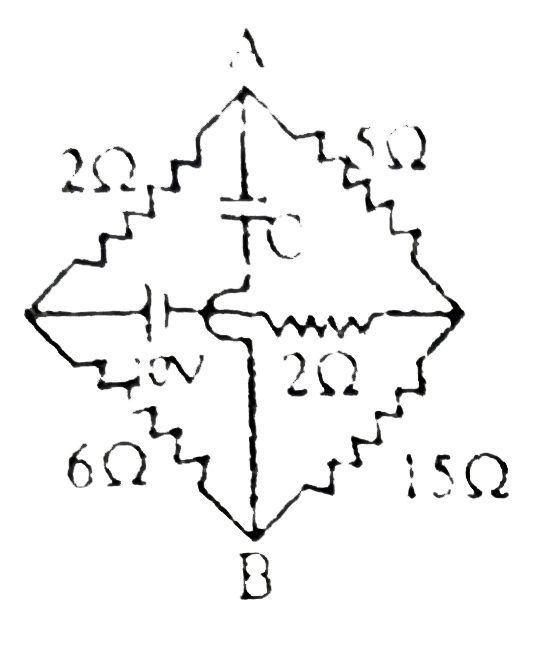What is VA−VB in the arrangement shown in.What is the condition such that VA−VB=0
Let the charge be as shown in. We know that capacitors in series have the same charge. Considering the loop containing C1,C2 and E, we get

qC1+qC2−E=0
or q=E[C1C2C1+C2]
from the loop containting C3,C4, and E, we get
q'C3+q'C4−E=0 or q'=E[C3C4C3+C4]
Now
VA−VB=qC2−q'C4=E[C1C1+C2−C3C3+C4]
=E[C1C4−C3C2(C1+C2)(C3+C4)]
For VA−VB=0,C1C4=C2C3=0. If (C1/C2)=(C3/C4), the potential difference across A and B will be zero . This statement is very important is capacitor circuit solving. This type of the situation is callede balacned Wheatstone bridge.
Topper's Solved these Questions
- CAPACITOR AND CAPACITANCEBOOK - CENGAGE PHYSICS ENGLISHCHAPTER - CAPACITOR AND CAPACITANCEEXERCISE - Solved Examples
10 Videos
- CAPACITOR AND CAPACITANCEBOOK - CENGAGE PHYSICS ENGLISHCHAPTER - CAPACITOR AND CAPACITANCEEXERCISE - Exercise 4.1
13 Videos
- ATOMIC PHYSICSBOOK - CENGAGE PHYSICS ENGLISHCHAPTER - ATOMIC PHYSICSEXERCISE - ddp.4.3
15 Videos
- CENGAGE PHYSICS DPPBOOK - CENGAGE PHYSICS ENGLISHCHAPTER - CENGAGE PHYSICS DPPEXERCISE - subjective type
51 Videos
Similar Questions
Find VA−VB in steady state

View SolutionPotentail difference VA−VB in the network shown in

View SolutionPotential difference VB−VA in the network shown is

View SolutionIn the circuit shown, what is the potential different VPQ ?

View SolutionVA−VB for given figure in steady state is

View SolutionThe circuit consists of resistors and ideal cells. I1 and I2 are current through branches indicated in the figure, VA and VB is the potential at points A and B on the circuit

The value of VA−VB in volts is:
View SolutionDetermine the potential difference VA−VB between point A and B of the circuit shown in figure . Under what condition is it equal to zero ?

View SolutionFind the equivalent resistance of the network between the point A and B shown in the figure . If A and B are connected to a 13 V battery so that VA>VB . Find (a) the current in each resistor (b) the potential difference Vab=Va−Vb .

View Solution
In the part of the circuit shown in the figure, the potential difference between points VA−VB=16V. The current passing through the 2Ω resistance will be
View SolutionIn the circuit shown, what is the potential difference VPQ in volts ?

View Solution
